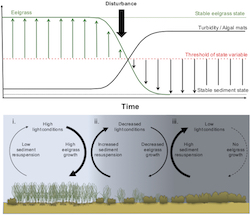ABSTRACT
Along the Swedish northwest coast, over 60% of the eelgrass meadows have been lost since the 1980’s. Despite improved water quality no recovery has occurred, and restoration is presently considered to mitigate historical losses. However, the factors preventing natural recovery of eelgrass are not known, and it is not clear if conditions would allow restoration.
Here we present the results from 5 years of field studies with the aim of identifying the key processes affecting eelgrass growth and survival at historical eelgrass areas. Continuous light measurements and comparison with historic eelgrass distribution indicate that the maximum depth distribution has decreased locally with 1.5-2.3 m in areas that have lost large eelgrass beds in the last 10-30 years.
Field studies suggest that wind driven local resuspension of sediments that are no longer stabilized by eelgrass beds is the main cause behind the deteriorated light conditions. Field experiments show that a combination of low light condition and disturbance from drifting algal mats prevent eelgrass recovery in these areas, whereas the sulfide intrusion from the sediment and dislodgement of shoots by waves had little effect on growth and survival.
These results suggest that local regime shifts acting on a scale of 40-200 ha have occurred after the loss of eelgrass beds, where increased sediment resuspension and proliferation of drifting algal mats act as feedback mechanisms that prevent both natural recovery and restoration of eelgrass. The feedbacks appear to be interacting and self-generating, causing an accelerating loss of eelgrass that is presently spreading to neighboring areas.












